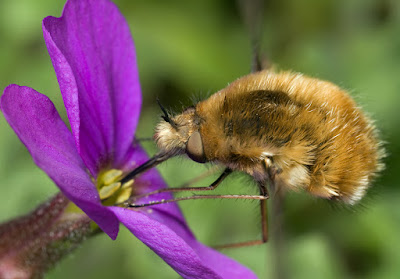Bti is thought to be non-toxic to most aquatic species, and direct effects on non-target species are thought to be mostly limited to larva of midges and crane flies. However, the larval and adult stages of these non-target organisms represent a major food source for both larval and adult odonates (dragonflies and damselflies). Midges are a major component of wetland food-webs, and their benthic (substrate-dwelling) lifestyle exposes them to Bti for much longer periods than is the case for mosquitoes, whose larvae and pupae dwell at the water's surface.
The Carmague is a wetland area in southern France, situated between the Mediterranean Sea and two arms of the Rhône River (the Grand-Rhône and the Petit-Rhône). The Camargue is a Ramsar site (wetland site recognized for international importance) represented by a mosaic of over 1450 square kilometers of salt marshes, reed beds, vernal ponds, lagoons, agricultural fields (mostly rice), and salt flats. It is an area of high biodiversity, hosting over 1000 vascular plant species and over 400 bird species.
Systematic spraying with Bti in the Camargue began in 2006, with the intention of reducing populations of mosquitoes which are generally a nuisance to tourists and locals. Bti is applied to the waters whenever the larvae of mosquito species Ochlerotatus (Aedes) caspius and O. (A.) detritus are detected.
Scientists have recently investigated the potential impact that Bti spraying may have on adult odonate populations; the rationale behind this is that reductions in food resources (e.g. larval and adult flies) may affect the suvival of larval and adult odonates. The study took place over a five-year period in the Camargue.
23 species of odonates were recorded during the five years of sampling. Unsprayed sites showed significantly higher species richness (number of odonate species) and abundance of odonates than sites sprayed with Bti. The average number of odonate species at unsprayed sites were twice that of sprayed sites. Odonate abundance at unsprayed sites were also twice that of sprayed sites on average. Significant differences in abundance were also observed when dragonflies and damselflies were analyzed separately. In addition, midges (the primary food source of odonates) were shown to be almost twice as abundant in unsprayed sites, compared to sprayed sites.
This was the first study to address the indirect effects of mosquito control on odonate communities. Direct effects of Bti on the larvae of a common dragonfly have been examined in laboratory experiments in 1996, and no mortality was documented. However, the results of the present study suggest that Bti spraying negatively impacts the number of species and individuals of adult odonates, due to dramatic reductions in food resources at chemically-treated sites. The reductions in odonate- and midge populations observed in this study are consistent with the results of another study conducted in the same region that looked ar breeding colonies of the house martin (Delichon urbicum). That study showed that adult house martins feed their chicks with a significantly lower proportion of mosquitoes, midges, and odonates when the breeding colony is surrounded by Bti-sprayed marshes, and this results in a 33% decrease in chick survival.
The direct and indirect effects of Bti on various insect groups can have cascading negative impacts through wetland food-webs. Dragonflies and damselflies are of high conservation interest, and mosquito control using Bti should be acknowledged as a threat to these insects, as well as other animal groups, in wetland ecosystems.
LINK to Jakob and Poulin's 2016 article in Insect Conservation and Diversity.
Systematic spraying with Bti in the Camargue began in 2006, with the intention of reducing populations of mosquitoes which are generally a nuisance to tourists and locals. Bti is applied to the waters whenever the larvae of mosquito species Ochlerotatus (Aedes) caspius and O. (A.) detritus are detected.
Scientists have recently investigated the potential impact that Bti spraying may have on adult odonate populations; the rationale behind this is that reductions in food resources (e.g. larval and adult flies) may affect the suvival of larval and adult odonates. The study took place over a five-year period in the Camargue.
23 species of odonates were recorded during the five years of sampling. Unsprayed sites showed significantly higher species richness (number of odonate species) and abundance of odonates than sites sprayed with Bti. The average number of odonate species at unsprayed sites were twice that of sprayed sites. Odonate abundance at unsprayed sites were also twice that of sprayed sites on average. Significant differences in abundance were also observed when dragonflies and damselflies were analyzed separately. In addition, midges (the primary food source of odonates) were shown to be almost twice as abundant in unsprayed sites, compared to sprayed sites.
This was the first study to address the indirect effects of mosquito control on odonate communities. Direct effects of Bti on the larvae of a common dragonfly have been examined in laboratory experiments in 1996, and no mortality was documented. However, the results of the present study suggest that Bti spraying negatively impacts the number of species and individuals of adult odonates, due to dramatic reductions in food resources at chemically-treated sites. The reductions in odonate- and midge populations observed in this study are consistent with the results of another study conducted in the same region that looked ar breeding colonies of the house martin (Delichon urbicum). That study showed that adult house martins feed their chicks with a significantly lower proportion of mosquitoes, midges, and odonates when the breeding colony is surrounded by Bti-sprayed marshes, and this results in a 33% decrease in chick survival.
The direct and indirect effects of Bti on various insect groups can have cascading negative impacts through wetland food-webs. Dragonflies and damselflies are of high conservation interest, and mosquito control using Bti should be acknowledged as a threat to these insects, as well as other animal groups, in wetland ecosystems.
LINK to Jakob and Poulin's 2016 article in Insect Conservation and Diversity.

































